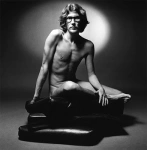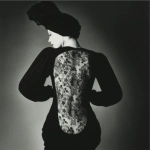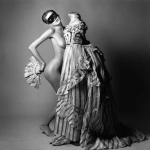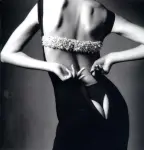There is a very large book available in book shops near you and if it isn’t then it is well worth your while to order it. Here is the good news, its discounted for us in India and makes a, must buy.
At any price Jeanloup Sieff is well worth the money, when its a retrospective of a 40 year backward glance, in large format, beautifully produced, thick, and ‘on special’ then you have no excuse.
Jeanloupe Sieff is an icon born of Polish parents in Paris. But Sieff is timeless and a cosmic being, like a quasar or white giant, you can claim to belong to him and simultaneously he IS, unique, by himself, enigmatic and elusive.
Sieff’s work in the 50s looks fresh and contemporary even today, there is no patina, it seems to have slid off his Rolliflex this morning, he is not an imitator and simply follows the dictates of his own aesthetic which is always 10 steps ahead of the rest of the world. He is known to be a fashion photographer even when he is not shooting women and clothes. His work is fashion, and fashionable, eminently copy able. He creates style that people follow.
When you read the forward, and you must read the forward always in a retrospective, looking back, you get the feeling that this is a man with enormous life experience, a man who has travelled within and without, a man who has tasted and a man who has loved. What is most endearing is his literary je ne sais quoi. An easy walk down the Seine and insane, a glimpse into the artists mind and really his heart. There is a wonderful humour, self deprecating at times. The captions to the photographs are like haiku, pithily joining the visual with the verbal. Sieff has considerable verbal agility, an ability to make simple the profound. He claims that there is no art only artists and their work.








Even when he was hired by Elle and was riding in fast cars with beautiful women he began to tire of what he calls ‘the frills and furbelows of fashion and that trilogy of the superficial: models, couturiers and hairdressers’, so he ‘took the holy orders of photojournalism and joined Magnum which was austere and photographically and politically committed, presided over by the Cartier Bresson and Marc Riboud, Ernst Hass and other warrior-monks’.
Jeanloup Sieff is deep. You can’t help but be affected by his work, which he tries hard to distill from the ‘oeuvre’ and edifice. His images have a direct quality that communicate swiftly. However there is always something to return to, a nuance, a twitch, a premonition. You have no choice but to own this book, possess it and let it possess you. It can’t but affect the way you breathe like an asana that gives your lungs more capacity to find oxygen in a polluted world. His images can be caressed visually and for the visually impaired no doubt running your finger tips along the bromide must set you tingling.